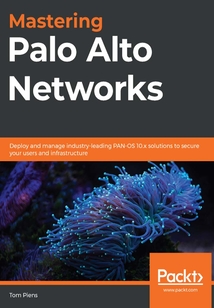舉報 

會員
Mastering Palo Alto Networks
Tosafeguardagainstsecuritythreats,itiscrucialtoensurethatyourorganizationiseffectivelysecuredacrossnetworks,mobiledevices,andthecloud.PaloAltoNetworks’integratedplatformmakesiteasytomanagenetworkandcloudsecurityalongwithendpointprotectionandawiderangeofsecurityservices.Withthisbook,you'llunderstandPaloAltoNetworksandlearnhowtoimplementessentialtechniques,rightfromdeployingfirewallsthroughtoadvancedtroubleshooting.ThebookstartsbyshowingyouhowtosetupandconfigurethePaloAltoNetworksfirewall,helpingyoutounderstandthetechnologyandappreciatethesimple,yetpowerful,PAN-OSplatform.Onceyou'veexploredthewebinterfaceandcommand-linestructure,you'llbeabletopredictexpectedbehaviorandtroubleshootanomalieswithconfidence.You'lllearnwhyandhowtocreatestrongsecuritypoliciesanddiscoverhowthefirewallprotectsagainstencryptedthreats.Inadditiontothis,you'llgettogripswithidentifyingusersandcontrollingaccesstoyournetworkwithuserIDsandevenprioritizetrafficusingqualityofservice(QoS).Thebookwillshowyouhowtoenablespecialmodesonthefirewallforsharedenvironmentsandextendsecuritycapabilitiestosmallerlocations.Bytheendofthisnetworksecuritybook,you'llbewell-versedwithadvancedtroubleshootingtechniquesandbestpracticesrecommendedbyanexperiencedsecurityengineerandPaloAltoNetworksexpert.
目錄(107章)
倒序
- 封面
- 版權信息
- Why subscribe?
- Contributors About the author
- About the reviewers
- Packt is searching for authors like you
- Preface
- Section 1: First Steps and Basic Configuration
- Chapter 1: Understanding the Core Technologies
- Technical requirements
- Understanding the zone-based firewall
- Understanding App-ID and Content-ID
- The management and data plane
- Authenticating users with User-ID
- Summary
- Chapter 2: Setting Up a New Device
- Technical requirements
- Gaining access to the user interface
- Adding licenses and setting up dynamic updates
- Upgrading the firewall
- Hardening the management interface
- Understanding the interface types
- Section 2: Advanced Configuration and Putting the Features to Work
- Chapter 3: Building Strong Policies
- Technical requirements
- Understanding and preparing security profiles
- Understanding and building security rules
- Creating NAT rules
- Summary
- Chapter 4: Taking Control of Sessions
- Technical requirements
- Controlling the bandwidth with quality of service policies
- Leveraging SSL decryption to break open encrypted sessions
- Redirecting sessions over different paths using policy-based forwarding
- Summary
- Chapter 5: Services and Operational Modes
- Technical requirements
- Applying a DHCP client and DHCP server
- Configuring a DNS proxy
- Setting up high availability
- Enabling virtual systems
- Managing certificates
- Summary
- Chapter 6: Identifying Users and Controlling Access
- Technical requirements
- User-ID basics
- Configuring group mapping
- Setting up a captive portal
- Using an API for User-ID
- User credential detection
- Summary
- Chapter 7: Managing Firewalls through Panorama
- Technical requirements
- Setting up Panorama
- Device groups
- Setting up templates and template stacks
- Panorama management
- Summary
- Section 3: Maintenance and Troubleshooting
- Chapter 8: Upgrading Firewalls and Panorama
- Technical requirements
- Documenting the key aspects
- Preparing for the upgrade
- The upgrade process
- The rollback procedure
- Special case for upgrading older hardware
- The downgrade procedure
- Summary
- Chapter 9: Logging and Reporting
- Technical requirements
- Log storage and forwarding
- Configuring log collectors and log collector groups
- Logging Service
- External logging
- Configuring log forwarding
- Reporting
- The Application Command Center
- Filtering logs
- Summary
- z: VPN and Advanced Protection
- Technical requirements
- Setting up the VPN
- Custom applications and threats
- Zone protection and DoS protection
- Summary
- Chapter 11: Troubleshooting Common Session Issues
- Technical requirements
- Using the tools at our disposal
- Interpreting session details
- Using the troubleshooting tool
- Using maintenance mode to resolve and recover from system issues
- Summary
- Chapter 12: A Deep Dive into Troubleshooting
- Technical requirements
- Understanding global counters
- Analyzing session flows
- Debugging processes
- CLI troubleshooting commands cheat sheet
- Summary
- Chapter 13: Supporting Tools
- Technical requirements
- Integrating Palo Alto Networks with Splunk
- Monitoring with Pan(w)achrome
- Threat intelligence with MineMeld
- Exploring the API
- Summary
- Other Books You May Enjoy 更新時間:2021-06-11 18:34:28
推薦閱讀
- .NET Core 2.0 應用程序高級調試:完全掌握Linux、macOS和Windows跨平臺調試技術
- 網絡工程
- Axure RP 7.0從入門到精通:Web + APP產品經理原型設計
- 計算機網絡技術及應用
- 計算機網絡技術基礎(第2版)
- 云計算和大數據技術實戰
- CSS網頁布局與瀏覽器兼容
- 計算機網絡
- Learning SaltStack
- UG NX 12.0數控編程與加工案例教程
- Cisco Unified Communications Manager 8:Expert Administration Cookbook
- 對話大數據 政府/工業/金融/醫療/人才行業創新與應用案例分析
- 掌控你的工作!:巧用Outlook極速提升工作效率
- Python Network Programming
- 全球網絡身份管理的現狀與發展
- 云原生:運用容器、函數計算和數據構建下一代應用
- 虛擬網構建及其應用
- 網頁制作案例教程(第2版)
- 私有云存儲系統搭建與應用
- Bootstrap Web設計與開發實戰
- 網頁設計與制作:Dreamweaver+Flash+Photoshop+HTML5+CSS3(慕課版)
- Prometheus云原生監控:運維與開發實戰
- 云計算原理與實踐
- 命名數據網絡原理、技術與應用
- Drupal 8 Development Cookbook
- 計算機網絡(第2版)
- 給想當程序員的你:程序員面試寶典與進階秘笈
- Windows Azure云計算實踐
- PHP動態網站開發項目實戰
- DreamweaverCS6+HTML+CSS+DIV+JavaScript網站開發案例教程

